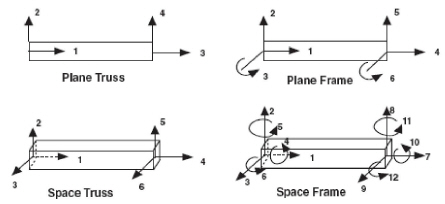2.6Structure Types
The structure type is determined by the type of members used to model it. There are four types of members in spFrame. Members include 2-D Frames, 3-D Frames, 2-D Trusses, and 3-D Trusses. They differ from each other by the number of degrees of freedom per joint. A degree of freedom refers to the direction in which the joint can move or rotate.
Two-dimensional plane frame members have three degrees of freedom per joint displacement in the global X direction, displacement in the global Y direction, and rotation about the global Z-axis. Plane frame members can be subjected to in-plane loads that can cause axial, shear, and bending stresses.
Three-dimensional space frame members have six degrees of freedom per joint displacements in the global X, Y, and Z directions, and rotations about the global X, Y, and Z axes. Space frame members can be subjected to forces and moments in any direction.
Two-dimensional plane truss members have two degrees of freedom per joint— displacement in the global X direction and displacement in the global Y direction. By definition, trusses are loaded only at the joints so that members are subjected to axial forces only (no bending moments or shears). Although member loads can be applied to truss members in spFrame, these loads are converted to equivalent joint loads before the structure is solved.

Figure 2.5
Three-dimensional space truss members have three degrees of freedom per joint displacement in the global X direction, displacement in the global Y direction, and displacement in the global Z direction.